Whelping Bitch: How To Tell If Your Dog Is About To Give Birth To Puppies
Breeding your dog is a rewarding time particularly when all goes smoothly.
For most dogs, giving birth to puppies is easy, however on occasion difficulties with labour do occur, so it’s best to be prepared.
In this article, we want to ensure that you are fully prepared.
Read on to learn more about how to prepare your whelping bitch and her environment for the birth, how to recognise signs your dog is going into labour, how much time between puppies is normal and how to recognise when the delivery is not proceeding normally and you need to contact a vet.
Let’s get right to it.

Newborn puppies.
Worried? Contact A Vet
Before we start, if you are concerned about your whelping bitch and need to speak with a vet, we are available 24/7.
Our vets can talk you through the birth process and if we decide you need to go to a clinic we will tell you immediately.
Yes, I’d like to speak with a vet
Preparation For Delivery Of Pups
Most bitches will whelp without any issues and the less you interfere the better.
However, there are some occasions when you may have to step in and assist your bitch.
In preparation for the time of whelping, make sure you have the following items on hand:
- thermometer
- prepared whelping box and area (located in a quiet location out of high traffic areas)
- lots of clean newspapers and towels
- hot water bottles, a heat lamp or heat pad
- water-based lubricant such as KY Jelly
- gloves
Signs Of Impending Whelping
Most dogs are pregnant for around 63 days giving birth on or around that date.
It’s not uncommon for a gestation period to range from 58-68 days due to dogs being receptive to males before and after ovulation and it being difficult to pin down an exact conception date.
In the days leading up to the birth, you may notice that the bitch’s vulva becomes enlarged, soft and flabby.
Her mammary glands will enlarge and she may even start to drip milk. (However, be warned – these signs also occur with a false pregnancy. If you are unsure whether your girl is pregnant, have your veterinarian examine her).
Signs A Dog Is Going Into Labour Soon
Canine parturition (labour) occurs in three stages.
Recognising the signs and stages of parturition will enable you to assess how the whole birthing process is going and when you might need to assist the mother.
By understanding the signs and stages of gestation, you will be able to assess how the whole birthing process is going and when you might need to give assistance.
If you are concerned, remember our team of vets are available 24/7.
First Stage Labour
The first stage of labour starts about 24 hours prior to birth and lasts anywhere from 6-12 hours.
In these hours before whelping the most common behavioural signs you will see include:
- going off food either being very picky or not eating at all
- some may vomit
- showing nesting behaviour, pacing, digging and seeking out hiding spots
More objective signals that your dog will be giving birth soon include:
- a drop in body temperature by approximately 1 degree
- a blood progesterone level that drops from 5-10 ng/ml to 2-3 ng/ml.
A sure sign that a bitch is going into labour soon is that her body temperature will drop.
While the normal rectal temperature for a dog ranges between 37.5°C to 38.5°C (99.5°F to 101.3°F), it’s not uncommon to see the mother’s temperature drop by 1.1 – 1.7°C, 6 to 18 hours before they give birth.
For this reason, we recommend that when the due date is approaching, start taking her rectal temperature twice daily so that you can get a guide as to what her normal temperature is and can recognise this temperature drop when it occurs.
You may also notice a clear or mucous-like discharge from the vulva, indicating that her cervix is starting to open in preparation for birth.
All vaginal discharge from the mother dog prior to birth of a pup should be CLEAR
Second Stage Labour
The second stage labour is when we have the birth of puppies!
Before the first pup is born, the bitch may show signs of weak and inconsistent pushing and straining for up to 2 hours.
The colour of the pregnant dog’s vaginal discharge BEFORE pups are born should always be CLEAR.
If you see dark red to brown or green discharge prior to any pup being born, please go to your vet immediately.
This is a sign that the placenta has come away from the uterus and means the pups will lack oxygen.
Your bitch will likely require an emergency caesarean.
If weak, inconsistent straining continues for longer than two hours without any signs of a watery discharge (“water breaking”) or puppies, it is wise to check in with a veterinarian for guidance.
As abdominal contractions become stronger and more frequent you will see more clear discharge, and the presentation of a round, golf-ball-size membrane sac of water.
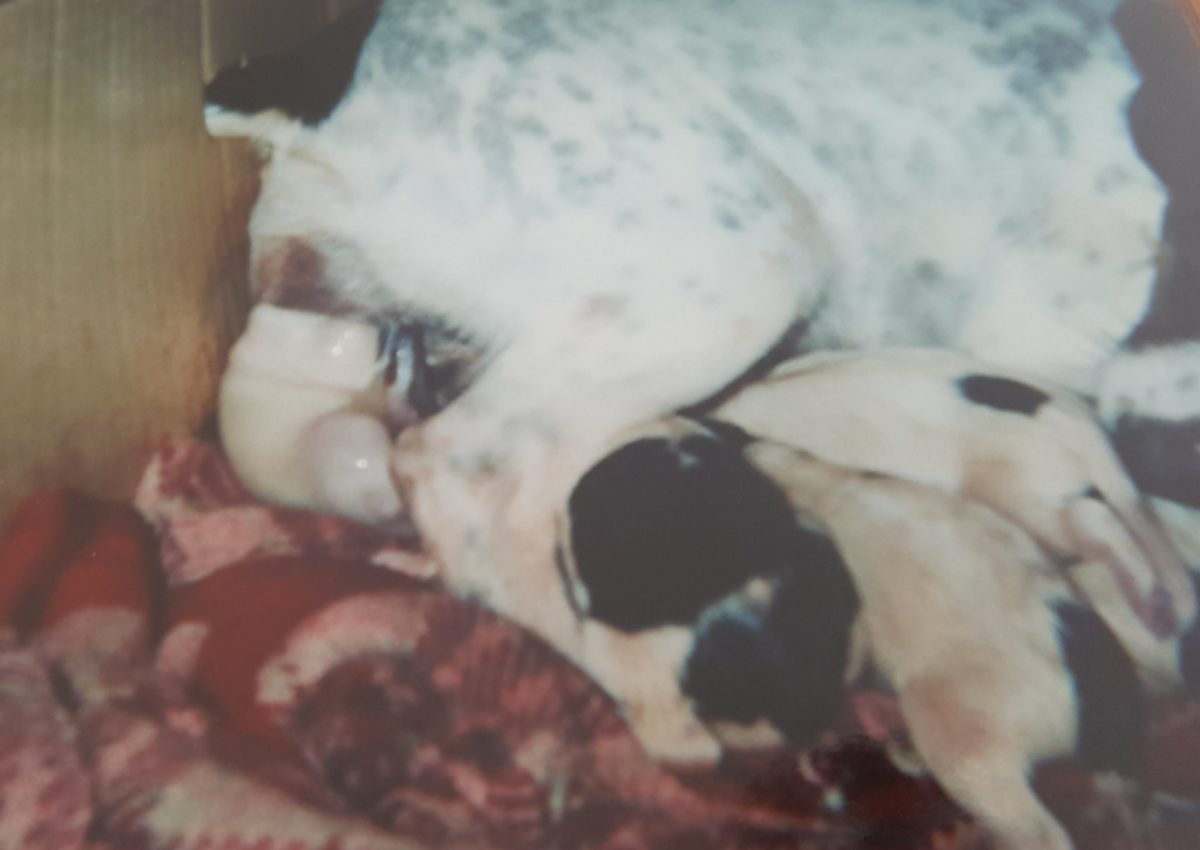
Here we can see a dog giving birth with a pup being born. The water sac is still intact over the pup’s body.
This ‘water sac’ is still the 2nd stage of labour and is sometimes called a horn sac.
After the presentation of this sac and active straining, the pup should be born in about 30 minutes.
If you see a water sac with no puppy and the bitch continues to strain hard for 20- 30 minutes, please get in touch.
Third Stage Labour
The third stage labour is the period after the birth of each pup when the placenta is expelled.
Expulsion of the placenta after the delivery of a pup is known as afterbirth.
It normally occurs within 15minutes of a pup being born.
You may not notice the placenta being expelled as many bitches will eat them as they are busy licking and cleaning the pups.
It isn’t a problem if your bitch eats a placenta, although some bitches will vomit, so you may decide to dispose of them yourself.
During this period the bitch is either resting and ‘getting’ her breath, cleaning pups and or feeding them.
If your bitch is overweight or has a large litter of pups to birth, she will tire.
Please keep an eye on her.
Likewise, if there is a sac present or the ‘waters have broken’ and there is no active straining for more than 2 hours then please contact us.
First-time mothers should be attended to by their owners until at least one or two pups have been born.
If there are no problems, further attendance will depend upon the desire of your pet and the situation.
It is worthwhile checking every couple of hours as if there is no progress then your bitch is likely to need help.
Some dogs prefer you to be present while others prefer to be left alone.
It’s also worth noting that breech births (where the hindlimbs present to the birth canal first) and posterior presentation in dogs are common and are not a reason to worry.
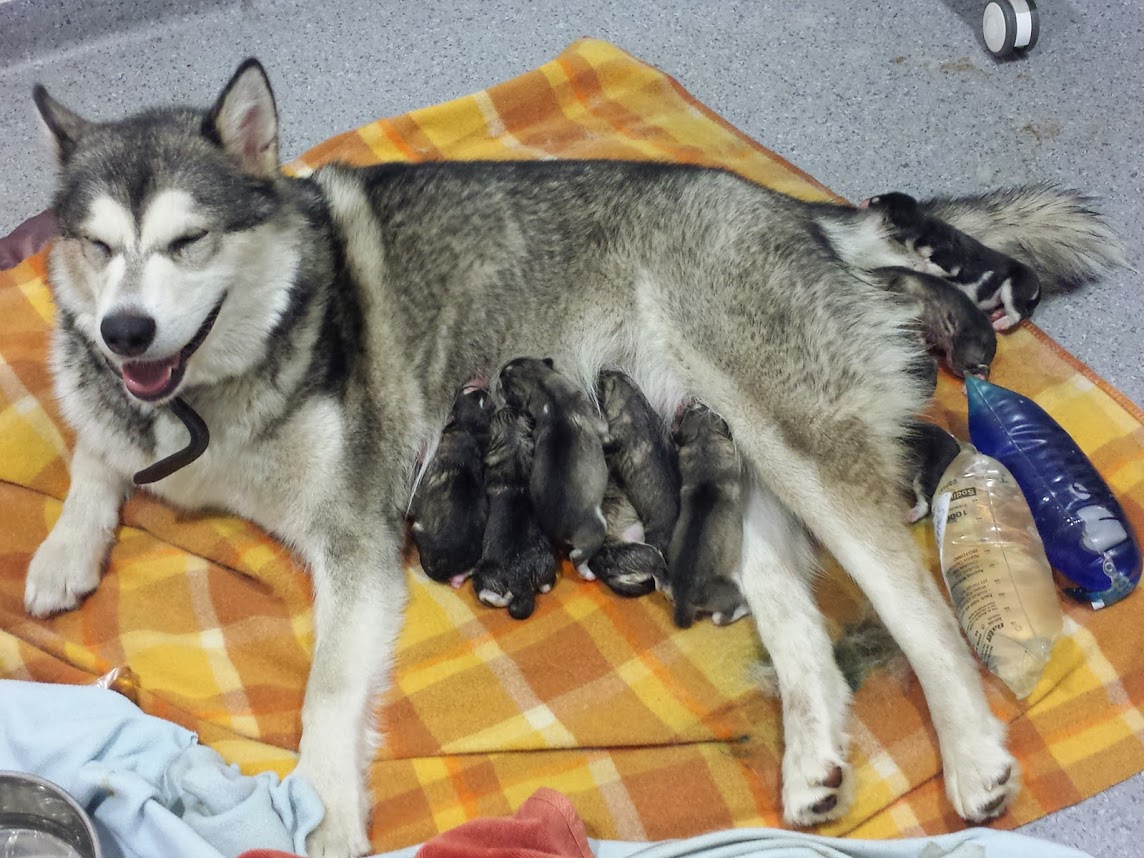
Having puppies is exhausting work!
How Long Between Puppies Is Normal?
Most dogs will give birth to a puppy every 30-60 minutes.
If more than 2 hours have passed since the previous pup was born please watch your girl closely.
It’s not unusual for the interval between pups to increase to up to 4 hours between pups in some circumstances, particularly if birthing a large litter or if the bitch begins to tire.
If the bitch is resting quietly with no active straining or abdominal contractions then there is less cause for concern.
If a bitch is actively straining then stops, please contact a vet.
When Do I Become Concerned About My Bitch?
Contact A Vet For Advice If:
- More than two hours have passed without any puppies being born after the start of stage 2 labour.
- There is a green or black vaginal discharge prior to any pups being born.
- More than two hours pass between puppies.
- Continual straining for 20 minutes with a puppy or fluid-filled bubble stuck in the birth canal.
- Your dog has intense contractions/straining for more than 20 minutes without a puppy being delivered.
- If your dog is depressed, lethargic or her body temperature is less than 37.5°C or more than 39.5°C
- If she is bleeding from the vagina for more than ten minutes.
- If a puppy’s tail is seen hanging from the vulva or alternatively there is a lump just behind the vulval lips and your bitch is straining, it is probably a breech presentation. Some posterior presentations can be delivered without assistance, but often complications occur.
- The bitch hasn’t given birth within 70days of mating (prolonged gestation).
If you are concerned about your bitch and need to speak with a vet, we are available 24/7.
What To Do If Birth Stops?
Sometimes you can see that a puppy is present in the vulva and the bitch may be having trouble pushing it out.
With clean or gloved hands, gently take hold of the puppy.
Gently pull the puppy at approximately 135° downward angle (from the verticle).
Keep a constant pull even when your girl is not straining, as gentle traction will stimulate her to keep straining.
If the puppy does not move or if it appears to be stuck, contact a vet urgently.
Be careful that the bitch doesn’t bite you! Birth is painful!
What To Do If You Need To Take Your Girl To The Vet
If you do need to take your bitch to the vet, they will often advise leaving any puppies already born, at home.
Your vet will advise whether to bring them in or leave them at home.
Make sure any puppies she has already delivered are in a secure box with a heat source such as a hot water bottle, heat pad or heat lamp to keep them warm.
Ensure any hot water bottle used is well wrapped in a towel or similar to prevent overheating or burning the puppies.
If using a heat pad or lamp, make sure that any area of the whelping box is not heated so the pups can wriggle to a cool area.
If your bitch does require a caesar most veterinarians will recommend desexing at the same time.
Most bitches don’t need to stay in the hospital for long and are able to go home an hour or so later.
How Long Does Birth Of A Puppy Take?
Delivery of each individual pup should not take longer than 20-30 minutes.
However, the length of time for a dog to give birth to an entire litter can vary depending on the breed, fitness of the bitch and number of pups she’s expecting.
Dogs with fairly slim heads such as Collies and Dobermans may deliver all of their puppies within 2-3 hours.
Brachycephalic breeds, i.e. those with large, round heads such as Bulldogs and Pekingese, tend to have more difficult deliveries and sometimes will produce one or two relatively quickly and then rest for a while before labour starts again.
Bitches that are fit and healthy give birth faster than bitches that are overweight and unfit.
The larger the litter…the longer the process.
Remember if there is no sign of active labour for longer than 2 hours between pups, please contact a vet.
What Happens After Birth Of All The Pups?
Each puppy is enclosed in a sac that is part of the placenta or after birth.
This sac is usually broken at birth and passed after each puppy is born.
You may not see the placenta as it is normal for the bitch to eat it as it is being expelled.
The bitch normally chews at the umbilical cord and breaks it about an inch from the puppy.
Keep a close eye on your bitch as sometimes that can be over-enthusiastic and injure the puppy.
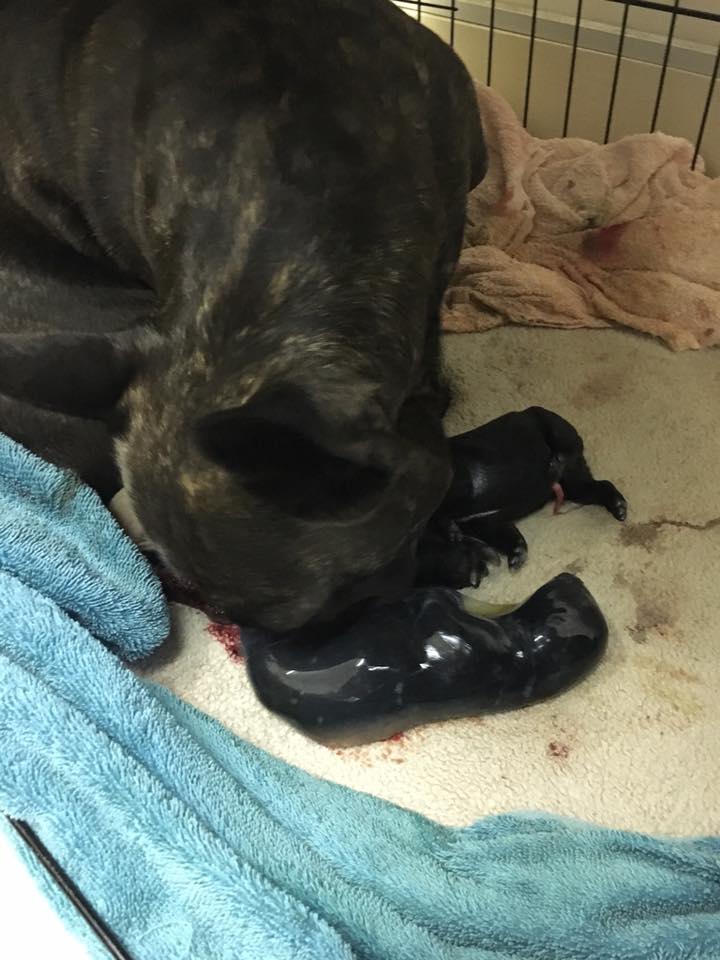
If the birth sac doesn’t break, or the bitch doesn’t break it you will need to remove it from the puppy’s face so that it can breathe.
If a puppy is born within the sac and the bitch does not break the sac within a few seconds, carefully break the sac yourself and then clean the puppy’s face and nostrils to allow it to breathe.
Ideally give the puppy straight back to the bitch, however, in some cases, you may find that the bitch is more interested in delivering the next pup in which case gently rub the puppy dry with a clean towel and place it in a box with a warm water bottle covered by a towel.
Cover the puppies to keep them warm.
Between births you can place pups on the bitch to begin feeding, however, sometimes the bitch is too restless, so if you think she will hurt them, be sure to monitor feeding and then keep them separate until after the final pup is born.
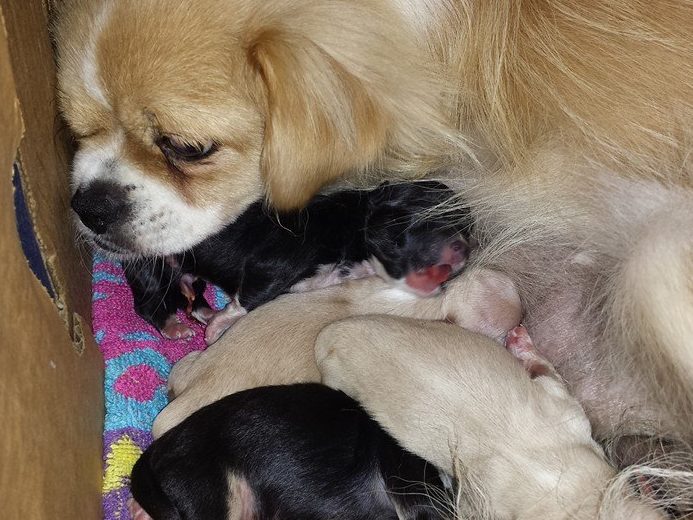
Care Of Mother And Pups In The Days After Birth
It’s important that all pups get access to a nipple and start feeding, move pups onto a nipple if you have to.
Settled, well-fed pups don’t cry.
If puppies are screaming and crying this generally means there is an issue and you will need to call a vet to discuss what to do.
Ensure your bitch has lots of TLC and lots of food and water.
Producing milk for her puppies takes up a lot of energy and is thirsty work.
Ensure she has constant (adlib) access to freshwater and puppy biscuits in at least the first few days after birth.
Watch her weight, if she looks like she is losing too much body condition, increase the amount of food you are offering at each feed, or keep adlib feeding for longer.
How Long Are Dogs Pregnant For?
Pregnancy gestation in the dog lasts between 58 and 68 days with most bitches giving birth around the 63-day mark.
It’s a wise idea to keep a calendar with all the important dates:
- when she joined the dog
- forecast birthing date
- when to organise vaccination, worming, Xrays
What Happens In The Last Week Of Pregnancy?
It’s exciting when the pregnancy due date is imminent, however, it’s always best to be prepared.
Our recommended ‘to-do’ list is:
Get An Abdominal Xray
Most veterinarians will recommend that you radiograph the mother dog in the last week of pregnancy to determine exactly how many puppies to expect.
In the last week to 10 days of pregnancy, the skeletons of the puppies are ossified enough so that we can count the number of pups.
There is a lot of peace of mind knowing when the last pup has been born and you can head to bed!
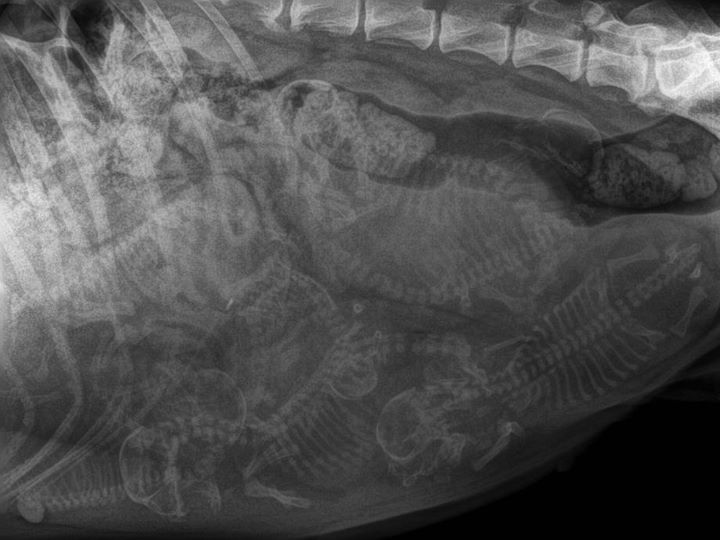
Radiograph of the abdomen of a pregnant bitch in the last week of pregnancy. How many puppies can you see?
Give An Allwormer Parasite Medication
Roundworms and hookworms can be transferred to pups from the bitch via the bloodstream and milk.
Tapeworms can be transferred if there are fleas in the environment (there are always fleas in the environment!).
It is recommended that you worm your pregnant dog in the last week of pregnancy with an all wormer that will kill all types of worms, especially hookworm.
Build A Whelping Box
During the last week of pregnancy, the mother dog may start to look around for a suitable place to have her puppies and show signs of nesting.
It is a good idea to get her used to the place where you want her to have her puppies well in advance by providing a suitable whelping box for her.
However, if she does start to whelp in an area other than the one you planned, it may be less stressful for all concerned to allow her to continue in her chosen place.
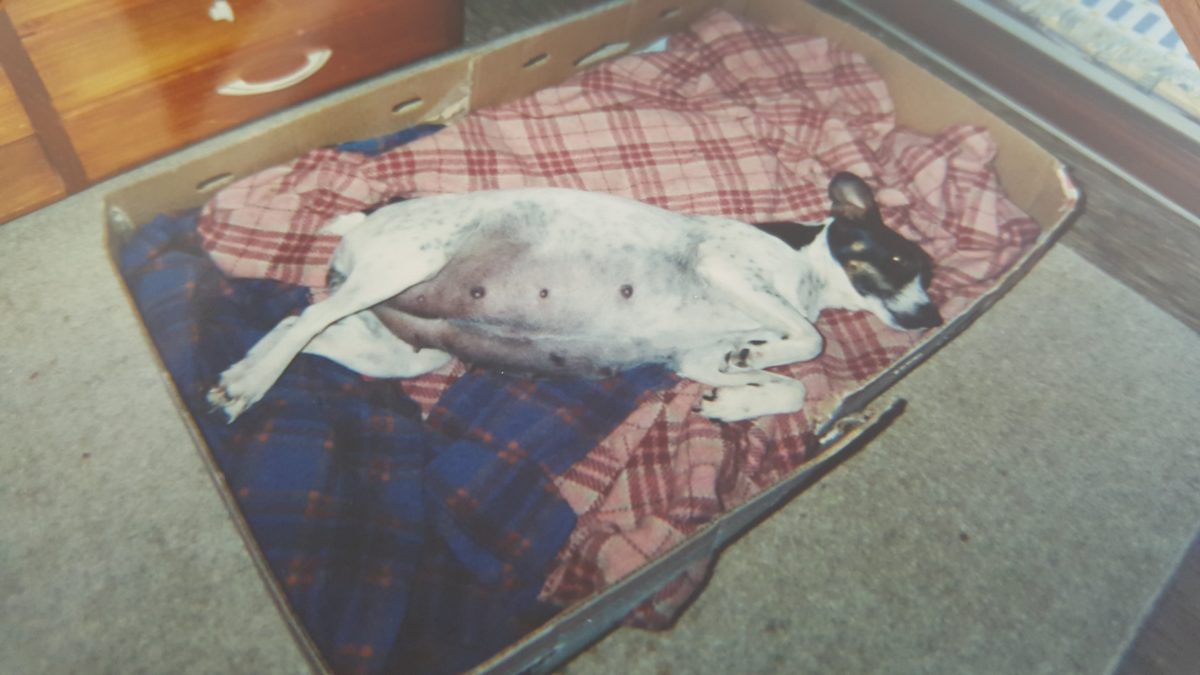
A whelping box in a quiet place provides the bitch with a safe area to give birth.
Once you have decided on an appropriate nesting area, make sure you spread lots of old newspaper and if possible, cover the carpet with a polythene sheet.
Birth can be a messy experience with green birthing fluids!
Provide Wholesome Nutrition
Most dogs lose their appetite in the last week or so of pregnancy.
Therefore it is extremely important that the food you have on offer is nutritious and provides everything she needs even if she is only eating a small amount.
Please feed your bitch a puppy formula biscuit as this has all the appropriate ingredients to support not only her health but also that of the pups when they arrive.
A puppy formula kibble has the correct mineral and vitamin balance required for growth.
Do not provide extra calcium supplementation unless specifically advised by your veterinarian.
How to choose an appropriate dog food for your breeding dogs.
Some bitches will stop eating completely during the last 24 hours before labour, this is to be expected and is considered quite normal.
Final Considerations When Breeding Dogs
For the majority of dogs, the birth of pups occurs without any difficulty.
However, certain breeds are predisposed to issues, and you should attempt to learn as much as possible about these prior to breeding your bitch.
It is worthwhile forming a close relationship with your veterinarian, not only to ensure that your bitch is healthy prior to whelping but so they are on-hand if things go wrong.
A vet can also assist once puppies are born particularly if there are puppy nursing problems.
Remember to plan ahead financially as even with all the best intentions and preparation, birthing issues do still occur.
Birthing problems such as dystocia (where the pups are stuck) and uterine inertia (where the uterus isn’t contracting to push pups out) require emergency treatment that can be expensive, particularly if these problems occur after hours.
If you are concerned about your bitch and need to speak with a vet, we are available 24/7.
We love to hear your stories related to breeding dogs. Tell us below in the comments.
Frequently Asked Questions:
How do I know if my dog still has puppies inside her?
The best way to determine if a dog still has puppies inside her is to x-ray her abdomen. Sometimes, it is possible to palpate and feel the presence of pups, but occasionally a pup may be within the birth canal and be missed using this method.
How long after giving birth does a dog bleed?
After giving birth, most dogs will have some vaginal discharge for up to 2-4 weeks.
This discharge is usually a muddy, brown colour and has no smell.
If discharge looks like bright red blood, has a foul smell or is thick and pus-like please have your bitch examined by a vet.
Further Related Reading
Should I Titre Test or Vaccinate My Dog
Do Dogs Need To Be Vaccinated Yearly?
What Vaccinations Do Puppies Need?

- 209
- 210

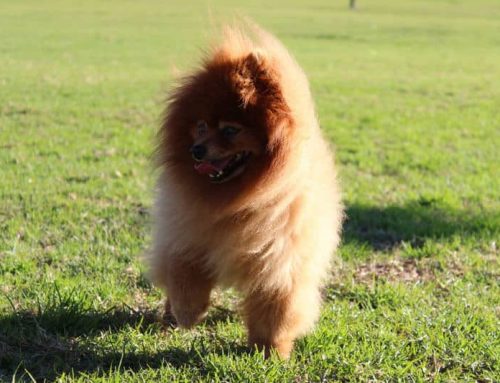

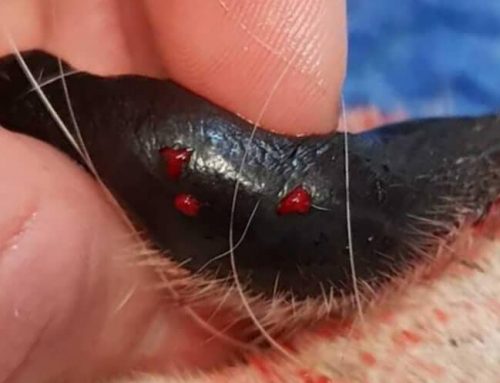
Rather contradictory: dont give medications but worm her?, also gently assist by moving puppy emerging at 45 degree angle, which way??? up, down or sideways,that is of zero help
Thanks for your comment Jen, we will update the statement regarding easing the puppy out at a 45 degree angle. The angle is down, moving with gravity.
I can’t see where the medications statement is, but in saying that it is important not to give anything without seeking veterinary advice. Worm treatments are safe.
brought a border collie from sunny side resue home
8 months old after 3 weeks I now have 4 pups
Oh Gosh Dennis, that is quite the surprise. I hope you are coping ok with it all!
Dr Leigh
Hi my frenchy is scaring me she breathing funny she is panting making grunts she wouldn’t even go out for weeshe also vomiting she dead restless an looks so said an not eating at all can u give me sum advice please she is booked in for c section on Thursday but I don’t think she will last that long tho do u think she in labour she also sounds like she struggles to breath grunting she won’t leave my side either can someone give me advise please x
Sorry we missed this comment Chantelle. I hope everything went ok.
We are at day 63 we believe our boxbull pitbull boxer cross. Has appeared to have ballooned over night. We have a whelping box area set up and are patiently waiting. The stud is a purebred pit bull heavy the bitch is 20months old and before her pregnancy she was a healthy 60lbs and muscular we have a vet who is a friend hopefully we can contact her before we start the process
My female Pug gave birth to six puppies 5 days ago unfortunately we have lost 2 of them and Mum is eating very little and not drinking. What can we do%%?
Oh no Jackie that doesn’t sound good at all. Please contact our vets at https://vip.yourvetonline.com/ask-a-vet-a-question/ and choose personal consult.
Our vets will be able to help with both Mum dog and the pups. We can advise how to supplement feed too.
All the best.